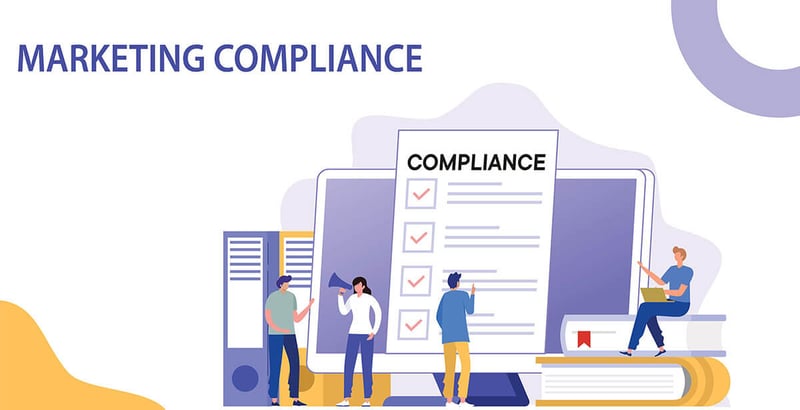Best Practices for Marketing Compliance in Tightly Regulated Industries
In recent years, there has been increased emphasis on data security and consumer protection, so much so that several countries around the world have enacted laws and regulations to protect consumers against data abuse and false claims. These rules and regulations are specifically applicable to the marketing industry and, when marketing in tightly regulated industries, they are even more stringent.
This means that failing to comply with compliance rules will most likely result in steep fines. That’s not even mentioning the reputational damage that could lead to a loss of customers, and of course, income.
As part of your business’s overall compliance strategy, marketing compliance plays an important role in ensuring that your marketing, promotional, and sales content comply with the necessary regulations that are in place to protect consumers against false claims and misleading advertising.
The problem is that, when creating and implementing digital marketing strategies, you produce so much content, digital assets, and other collateral that it becomes challenging to ensure that you comply with compliance rules and regulations. As such, you’ll need a compliance strategy that simplifies this process.
In this post, we’ll look at some best practices for marketing compliance you can implement. 
The State of Marketing Compliance
Before looking at these best practices in more detail, let’s first consider the state of marketing compliance in 2022. In Australia, marketing is governed by the Australian Consumer Law, which is enforced by the Australian Competition and Consumer Commission (ACCC).
This law sets out strict laws that businesses must follow when marketing their brands and products. In terms of it, businesses are prohibited from misleading consumers, either by making false claims or manipulating online reviews.
Some of the commission’s most recent decisions regarding marketing, however, relate to the use of social media and influencers. Some examples include actions against Runaway The Label, Tom Ford Beauty, and McDonald’s Australia, who all contravened the rules through the use of influencers. This is especially relevant as social media is an important component of any digital marketing strategy.
In addition, the Australian government released draft legislation that aims to increase the already high fines for non-compliance with the mentioned rules. In terms of the draft legislation, the maximum penalties for contraventions by companies of the rules could increase from $10 million to $50 million. Likewise, the maximum penalty applicable to individuals could increase to $2.5 million.
In the United States, the position relating to marketing regulation is no different, and marketing is regulated by Federal, State, and local laws. In the US, marketing regulations are primarily regulated by the Federal Trade Commission, and, for some industries, there are regulatory agencies that deal with marketing practices in certain industries like healthcare and finance.
As is the case with the Australian market, penalties in the US can also be severe and includes injunctions, prohibition of advertising certain products, and corrective advertising. More importantly, companies and individuals that contravene marketing rules can face fines of up to $16,000 per violation. This can add up to massive amounts. For example, the FTC recently sought a $5.5 million fine from Walmart and Kohl’s for deceptive marketing practices.
Best Practices to Maintain Marketing Compliance
Now that we have a broad overview of the state of marketing compliance, let’s look at the best practices you can implement in your marketing compliance strategy.
Involve Legal and Compliance Teams from the Outset
To ensure proper marketing compliance, it’s key that you involve your legal and compliance teams from the outset. After all, they are the experts in all things compliance. As such, you should involve them in your project approvals from the initial conception stages through digital asset creation, and finally publication.
When they’re involved in your workflows, you’ll have peace of mind knowing that every piece of content your team creates will be compliant. And, of course, when they’re involved from the beginning of the process, you’ll avoid working on digital assets that will never make it to the market.
Document Marketing Workflows
Another best practice you should implement is to document your marketing review and approval workflow. When you do this, you’ll give your team a roadmap they can follow for every project or campaign and map out every step of the process, including those that involve your legal and compliance team. This provides a consistent framework that not only makes your team more efficient, but also reduces errors and compliance risks.
You should also create clear guidelines that will accompany your roadmap. These guidelines determine the approaches your team will take when creating content, managing digital assets, and ensuring brand consistency, and will become a valuable resource for your team. Finally, remember to keep your workflows and guidelines updated as compliance regulations, market conditions, and your circumstances change.
Maintain Transparent Communication
Remember, when developing marketing campaigns and working on projects, your team will be more productive and efficient if they collaborate effectively and work together as a team. As a result, it’s key that all your team members are on the same page when it comes to managing your marketing projects.
For this reason, you should organize regular, typically weekly, update meetings. These meetings are perfect for discussing any issues your team has, including compliance issues. You should also ensure that everyone on your team is up to date with the most current compliance regulations and marketing protocols. New team members should also be brought up to date as quickly as possible and know where to find your latest guidelines. Here, transparent communication plays a vital role.
Automate Review and Approval Workflows
If you’re still using outdated and inefficient tools to manage your marketing projects, you should consider switching to marketing project and workflow management software. In fact, consider this as another best practice. When you make the switch, you’ll enjoy several benefits.
For one, you’ll be able to take advantage of automation and, by implication, eliminate many manual tasks. You’ll also be able to create custom review and approval pathways that ensure you don’t miss any steps before releasing collateral to the market. Not only will this eliminate errors, but your review and approval processes will be far more efficient, and your team will be more productive.
From a marketing compliance perspective, another benefit is that you’ll have access to a complete audit trail for every digital asset you create. As such, you’ll have clear insight into who reviewed the assets, what feedback was given, and what changes were made. This is especially valuable in, for example, marketing compliance in the finance industry.
Monitor Compliance
When you’ve implemented the steps above, you’ll probably have clear guidelines that your team can follow when creating content, and defined review and approval workflows that guide content and assets through every step of the approval process. However, these won’t amount to much if your team fails to follow through and actually use them.
As such, you should consistently monitor compliance. While, to some extent, your team will do this during the review and approval process, you should also check every piece of content generated by your team to make sure it's compliant. In this way, no non-compliant assets or content make it to the market.
Stay Current With Regulations
You should also ensure that you and your team always stay updated with the latest compliance rules and regulations. This is simply because these regulations can change on a dime as the marketing, and other industries evolve. There are several ways you could do this.
For example, you could schedule regular, monthly, or quarterly meetings with your legal and compliance team. They can tell you about recent or upcoming changes in rules or regulations in your industry. Another option would be to register to receive regular updates from regulatory bodies. Either way, you’ll ensure that you and your team always know the latest rules and how they impact you.
Use the Right Tools
Finally, one of the most important best practices is to use the right tools. We’ve already mentioned how a marketing project management and workflow tool can eliminate compliance risks and make your team more efficient. Apart from, as mentioned earlier, defined workflows and audit trails, marketing compliance software also offers features like approval checklists, automated reminders, digital asset management, and more.
All these features ensure that your team stays compliant. To learn more about marketing approval workflow software and how it can help your manage your marketing compliance, get in touch with Simple Admation.


